
In mammals, invertebrates and most fish, the anus is the external body orifice at the exit end of the digestive tract (bowel), i.e. the opposite end from the mouth. Its function is to facilitate the expulsion of wastes that remain after digestion.
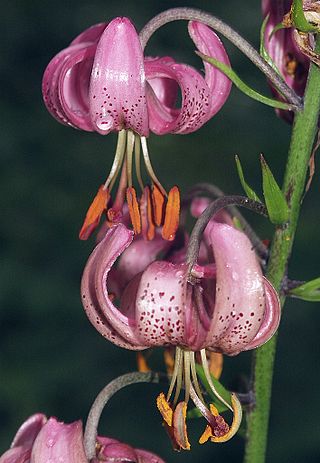
Liliales is an order of monocotyledonous flowering plants in the Angiosperm Phylogeny Group and Angiosperm Phylogeny Web system, within the lilioid monocots. This order of necessity includes the family Liliaceae. The APG III system (2009) places this order in the monocot clade. In APG III, the family Luzuriagaceae is combined with the family Alstroemeriaceae and the family Petermanniaceae is recognized. Both the order Lililiales and the family Liliaceae have had a widely disputed history, with the circumscription varying greatly from one taxonomist to another. Previous members of this order, which at one stage included most monocots with conspicuous tepals and lacking starch in the endosperm are now distributed over three orders, Liliales, Dioscoreales and Asparagales, using predominantly molecular phylogenetics. The newly delimited Liliales is monophyletic, with ten families. Well known plants from the order include Lilium (lily), tulip, the North American wildflower Trillium, and greenbrier.

Ctenophora comprise a phylum of marine invertebrates, commonly known as comb jellies, that inhabit sea waters worldwide. They are notable for the groups of cilia they use for swimming, and they are the largest animals to swim with the help of cilia.

Tentaculata is a class of comb jellies, one of two classes in the phylum Ctenophora. The common feature of this class is a pair of long, feathery, contractile tentacles, which can be retracted into specialised ciliated sheaths. In some species, the primary tentacles are reduced and they have smaller, secondary tentacles. The tentacles have colloblasts, which are sticky-tipped cells that trap small prey.

Beroidae is a family of ctenophores or comb jellies more commonly referred to as the beroids. It is the only family within the monotypic order Beroida and the class Nuda. They are distinguished from other comb jellies by the complete absence of tentacles, in both juvenile and adult stages. Species of the family Beroidae are found in all the world's oceans and seas and are free-swimmers that form part of the plankton.

Lobata is an order of transparent marine invertebrates belonging to the phylum of Ctenophora in the class Tentaculata, and are commonly referred to as comb jellies or sea gooseberries. There are currently 19 extant known species in the order of Lobata. Members of Lobata exhibit a compressed body in the vertical plane and a pair of oral lobes. They are known to inhabit marine pelagic surfaces and the marine shores.
Girdle of Venus may refer to:
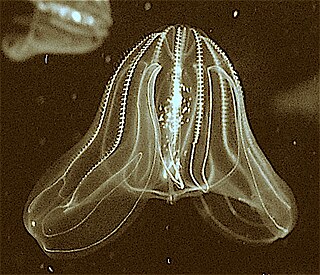
Mnemiopsis leidyi, the warty comb jelly or sea walnut, is a species of tentaculate ctenophore. It is native to western Atlantic coastal waters, but has become established as an invasive species in European and western Asian regions. Three species have been named in the genus Mnemiopsis, but they are now believed to be different ecological forms of a single species M. leidyi by most zoologists.
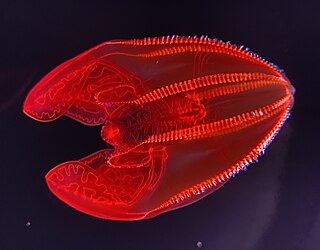
Lampocteis is a monotypic genus of comb jellies, the only genus in family Lampoctenidae. The sole species in this new genus is Lampocteis cruentiventer, the bloodybelly comb jelly. This ctenophore was first collected in the Pacific Ocean off the coast of San Diego, California, in 1979. It was described in 2001. The generic name was formed from the Ancient Greek lampós and kteís ("comb"), referring to the iridescence of its "combs"; the specific epithet was formed from the Latin cruentus ("blood-red") and venter ("belly"). Two morphological differences separating it from previously known comb jellies warranted the naming of a new family for this animal. These jellies are typically found at a depth of 250-1,500 meters deep in the North Pacific Ocean.

Ocyropsis is a genus of Ctenophores, which are commonly known as Comb Jellies. Ocyropsis belong to the family of Ocyropsidae. Ocyropsis possesses two large lateral muscular lobes and four auricles, and appear pale and translucent in color. Ocyropsis habitat is not precise as their gelatinous composition can make it difficult to study. They have been found in warm and cold waters. Unlike other, slow swimming Ctenophores, Ocyropsis are efficient in evading their predators. They use their oral lobes for additional propulsion and a secrete luminous mucous in efforts to evade predators. The muscular oral lobes of the Ocyropsis are used to grab its prey, and then moved to the prehensile mouth for absorption.

The Auriculariales are an order of fungi in the class Agaricomycetes. Species within the order were formerly referred to the "heterobasidiomycetes" or "jelly fungi", since many have gelatinous basidiocarps that produce spores on septate basidia. Around 200 species are known worldwide, placed in six or more families, though the status of these families is currently uncertain. All species in the Auriculariales are believed to be saprotrophic, most growing on dead wood. Fruit bodies of several Auricularia species are cultivated for food on a commercial scale, especially in China.

The Auriculariaceae are a family of fungi in the order Auriculariales. Species within the family were formerly referred to the "heterobasidiomycetes" or "jelly fungi", since many have gelatinous basidiocarps that produce spores on septate basidia. Around 100 species are known worldwide. All are believed to be saprotrophic, most growing on dead wood. Fruit bodies of several Auricularia species are cultivated for food on a commercial scale, especially in China.

Cydippida is an order of comb jellies. They are distinguished from other comb jellies by their spherical or oval bodies, and the fact their tentacles are branched, and can be retracted into pouches on either side of the pharynx. The order is not monophyletic, that is, more than one common ancestor is believed to exist.

Mertensia ovum, also known as the Arctic comb jelly or sea nut, is a cydippid comb jelly or ctenophore first described as Beroe ovum by Johan Christian Fabricius in 1780. It is the only species in the genus Mertensia. Unusually among ctenophores, which normally prefer warmer waters, it is found in the Arctic and adjacent polar seas, mostly in surface waters down to 50 metres (160 ft).
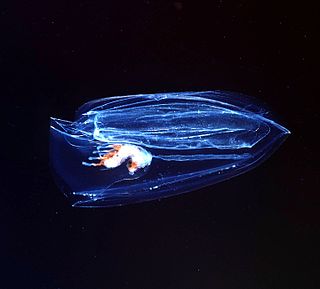
The benthic comb jelly is a comb jelly living in the Ryukyu Trench near Japan. Found at a depth of 7,217 metres (23,700 ft), it is the deepest dwelling ctenophore discovered. Since its discovery, similar comb jellies have been found in the New Britain and Yap trenches.

Beroe, commonly known as the cigar comb jellies, is a genus of comb jellies in the family Beroidae. Beroe exhibits bioluminescence.
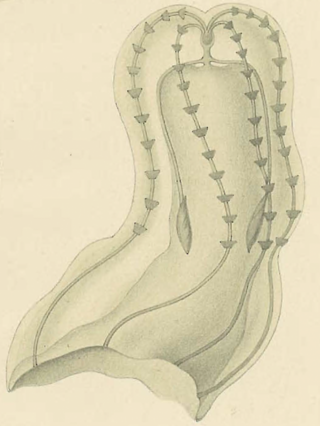
Ganesha is a genus of comb jellies. It is the only genus in the monotypic family Ganeshidae and the order Ganeshida. They are characterized by pair of small lobes round the mouth, and extended pharynx. Two species are currently recognized: Ganesha elegans and Ganesha annamita.

Neis is a genus of nudan ctenophores. It is a monotypic genus containing the single species Neis cordigera. It occurs only near Australia. As all beroids, it is a free-swimmer that form part of the plankton.
Duobrachium is a monotypic genus of comb jellies belonging to the order Cydippida, family unknown. The only species is Duobrachium sparksae.
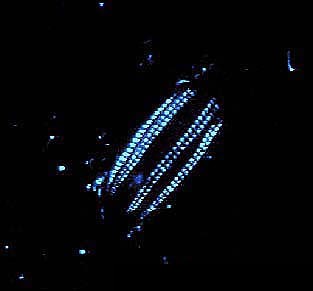
Euplokamis is a genus of ctenophores, or comb jellies, belonging to the monotypic family Euplokamididae. It shares the common name sea gooseberry with species of the genus Pleurobrachia. Despite living for hundreds of millions of years in marine environments, there is minimal research regarding Euplokamis, because they are uncommon. Research on the evolution of the basic body structures of diploblastic metazoans revealed that there are four major phyla, including the Ctenophores. Although the morphology of Euplokamis often resembles the medusa stage of Cnidarians, their eight rows of combs are one distinguishing feature that led to the official classification of Ctenophores. After being originally described by Chun (1879), the family Euplokamididae was expanded by Mills (1987) due to the discovery of a new species, Euplokamis dunlapae. Further research indicated that Euplokamis should be identified from Mertensiidae due to the rows of combs and some compression. They may also be distinguished from the genus Pleurobrachia due to their more elongated shape. Additionally, various adaptations of Euplokamis have been observed such as the use of tentacles for movement/feeding, a complex nervous system, and bioluminescent capabilities. Other characteristics including a defined mesoderm, lack of stinging cells, developmental differences, and symmetry supported the reclassification of these organisms.
















